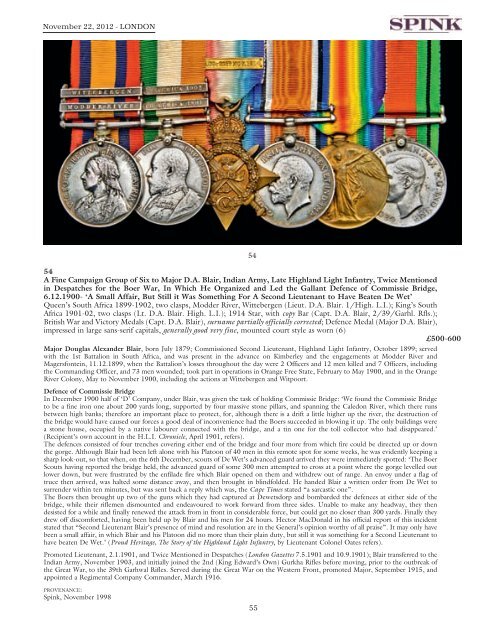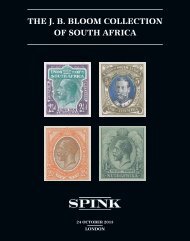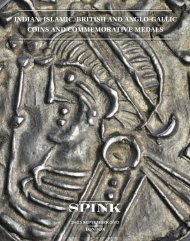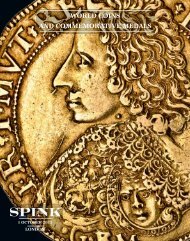orders, decorations, campaign medals and militaria - Spink
orders, decorations, campaign medals and militaria - Spink
orders, decorations, campaign medals and militaria - Spink
Create successful ePaper yourself
Turn your PDF publications into a flip-book with our unique Google optimized e-Paper software.
November 22, 2012 - LoNdoN<br />
54<br />
A Fine Campaign Group of Six to Major D.A. Blair, Indian Army, Late Highl<strong>and</strong> Light Infantry, Twice Mentioned<br />
in Despatches for the Boer War, In Which He Organized <strong>and</strong> Led the Gallant Defence of Commissie Bridge,<br />
6.12.1900- ‘A Small Affair, But Still it Was Something For A Second Lieutenant to Have Beaten De Wet’<br />
Queen’s South Africa 1899-1902, two clasps, Modder River, Wittebergen (Lieut. D.A. Blair. 1/High. L.I.); King’s South<br />
Africa 1901-02, two clasps (Lt. D.A. Blair. High. L.I.); 1914 Star, with copy Bar (Capt. D.A. Blair, 2/39/Garhl. Rfls.);<br />
British War <strong>and</strong> Victory Medals (Capt. D.A. Blair), surname partially officially corrected; Defence Medal (Major D.A. Blair),<br />
impressed in large sans-serif capitals, generally good very fine, mounted court style as worn (6)<br />
£500-600<br />
Major Douglas Alex<strong>and</strong>er Blair, born July 1879; Commissioned Second Lieutenant, Highl<strong>and</strong> Light Infantry, October 1899; served<br />
with the 1st Battalion in South Africa, <strong>and</strong> was present in the advance on Kimberley <strong>and</strong> the engagements at Modder River <strong>and</strong><br />
Magersfontein, 11.12.1899, when the Battalion’s losses throughout the day were 2 Officers <strong>and</strong> 12 men killed <strong>and</strong> 7 Officers, including<br />
the Comm<strong>and</strong>ing Officer, <strong>and</strong> 73 men wounded; took part in operations in Orange Free State, February to May 1900, <strong>and</strong> in the Orange<br />
River Colony, May to November 1900, including the actions at Wittebergen <strong>and</strong> Witpoort.<br />
Defence of Commissie Bridge<br />
In December 1900 half of ‘D’ Company, under Blair, was given the task of holding Commissie Bridge: ‘We found the Commissie Bridge<br />
to be a fine iron one about 200 yards long, supported by four massive stone pillars, <strong>and</strong> spanning the Caledon River, which there runs<br />
between high banks; therefore an important place to protect, for, although there is a drift a little higher up the river, the destruction of<br />
the bridge would have caused our forces a good deal of inconvenience had the Boers succeeded in blowing it up. The only buildings were<br />
a stone house, occupied by a native labourer connected with the bridge, <strong>and</strong> a tin one for the toll collector who had disappeared.’<br />
(Recipient’s own account in the H.L.I. Chronicle, April 1901, refers).<br />
The defences consisted of four trenches covering either end of the bridge <strong>and</strong> four more from which fire could be directed up or down<br />
the gorge. Although Blair had been left alone with his Platoon of 40 men in this remote spot for some weeks, he was evidently keeping a<br />
sharp look-out, so that when, on the 6th December, scouts of De Wet’s advanced guard arrived they were immediately spotted: ‘The Boer<br />
Scouts having reported the bridge held, the advanced guard of some 300 men attempted to cross at a point where the gorge levelled out<br />
lower down, but were frustrated by the enfilade fire which Blair opened on them <strong>and</strong> withdrew out of range. An envoy under a flag of<br />
truce then arrived, was halted some distance away, <strong>and</strong> then brought in blindfolded. He h<strong>and</strong>ed Blair a written order from De Wet to<br />
surrender within ten minutes, but was sent back a reply which was, the Cape Times stated “a sarcastic one”.<br />
The Boers then brought up two of the guns which they had captured at Dewetsdorp <strong>and</strong> bombarded the defences at either side of the<br />
bridge, while their riflemen dismounted <strong>and</strong> endeavoured to work forward from three sides. Unable to make any headway, they then<br />
desisted for a while <strong>and</strong> finally renewed the attack from in front in considerable force, but could get no closer than 300 yards. Finally they<br />
drew off discomforted, having been held up by Blair <strong>and</strong> his men for 24 hours. Hector MacDonald in his official report of this incident<br />
stated that “Second Lieutenant Blair’s presence of mind <strong>and</strong> resolution are in the General’s opinion worthy of all praise”. It may only have<br />
been a small affair, in which Blair <strong>and</strong> his Platoon did no more than their plain duty, but still it was something for a Second Lieutenant to<br />
have beaten De Wet.’ (Proud Heritage, The Story of the Highl<strong>and</strong> Light Infantry, by Lieutenant Colonel Oates refers).<br />
Promoted Lieutenant, 2.1.1901, <strong>and</strong> Twice Mentioned in Despatches (London Gazettes 7.5.1901 <strong>and</strong> 10.9.1901); Blair transferred to the<br />
Indian Army, November 1903, <strong>and</strong> initially joined the 2nd (King Edward’s Own) Gurkha Rifles before moving, prior to the outbreak of<br />
the Great War, to the 39th Garhwal Rifles. Served during the Great War on the Western Front, promoted Major, September 1915, <strong>and</strong><br />
appointed a Regimental Company Comm<strong>and</strong>er, March 1916.<br />
PROVENANCE:<br />
<strong>Spink</strong>, November 1998<br />
54<br />
55

















